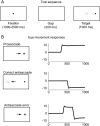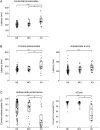Antisaccade task reflects cortical involvement in mild cognitive impairment
- PMID: 23986300
- PMCID: PMC3795604
- DOI: 10.1212/WNL.0b013e3182a6cbfe
Antisaccade task reflects cortical involvement in mild cognitive impairment
Abstract
Objective: The aims of this study were to examine executive dysfunction using an antisaccade (AS) task in normal elderly (NE) and patients with mild cognitive impairment (MCI) and Alzheimer disease (AD) as well as to evaluate the relationship between AS performance and cortical thinning within AD-associated regions.
Methods: We recorded eye movements in 182 subjects (NE: 118; MCI: 36; AD: 28) during an AS task. We also performed neuropsychological measures of executive function for comparison. Brain MRI scans were collected on most subjects, and cortical thickness was determined in 9 regions known to exhibit atrophy in AD dementia ("AD signature"). We investigated the relationships between AS and neuropsychological performance, as well as possible correlations between AS performance and cortical thickness.
Results: AS performance in MCI resembled that in NE; subjects with AD were impaired relative to both MCI and NE. In all subjects, AS performance correlated with neuropsychological measures of executive function, even after controlling for disease severity. In the subjects with MCI but not in NE, cortical thickness in frontoparietal AD signature regions correlated with AS performance.
Conclusions: The AS task is a useful measure of executive function across the AD spectrum. In MCI, AS performance may reflect disease burden within cortical brain regions involved in oculomotor control; however, AS impairments in NE may have etiologies other than incipient AD.
Figures


Similar articles
-
Cortical Thickness Correlates of Go/No-go and Motor Sequencing in Mild Cognitive Impairment and Suspected Alzheimer Disease Dementia.Cogn Behav Neurol. 2024 Sep 1;37(3):144-153. doi: 10.1097/WNN.0000000000000376. Cogn Behav Neurol. 2024. PMID: 39069962
-
Hippocampal hyperactivation associated with cortical thinning in Alzheimer's disease signature regions in non-demented elderly adults.J Neurosci. 2011 Nov 30;31(48):17680-8. doi: 10.1523/JNEUROSCI.4740-11.2011. J Neurosci. 2011. PMID: 22131428 Free PMC article.
-
Dysexecutive versus amnesic phenotypes of very mild Alzheimer's disease are associated with distinct clinical, genetic and cortical thinning characteristics.J Neurol Neurosurg Psychiatry. 2011 Jan;82(1):45-51. doi: 10.1136/jnnp.2009.199505. Epub 2010 Jun 20. J Neurol Neurosurg Psychiatry. 2011. PMID: 20562467 Free PMC article.
-
Saccade deficits in amnestic mild cognitive impairment resemble mild Alzheimer's disease.Eur J Neurosci. 2014 Jun;39(11):2000-13. doi: 10.1111/ejn.12617. Eur J Neurosci. 2014. PMID: 24890471
-
Working memory and executive function decline across normal aging, mild cognitive impairment, and Alzheimer's disease.Biomed Res Int. 2015;2015:748212. doi: 10.1155/2015/748212. Epub 2015 Oct 15. Biomed Res Int. 2015. PMID: 26550575 Free PMC article. Review.
Cited by
-
Afferent and Efferent Visual Markers of Alzheimer's Disease: A Review and Update in Early Stage Disease.Front Aging Neurosci. 2020 Sep 11;12:572337. doi: 10.3389/fnagi.2020.572337. eCollection 2020. Front Aging Neurosci. 2020. PMID: 33061906 Free PMC article.
-
Brain sex matters: estrogen in cognition and Alzheimer's disease.Mol Cell Endocrinol. 2014 May 25;389(1-2):13-21. doi: 10.1016/j.mce.2013.12.018. Epub 2014 Jan 11. Mol Cell Endocrinol. 2014. PMID: 24418360 Free PMC article. Review.
-
A detection model of cognitive impairment via the integrated gait and eye movement analysis from a large Chinese community cohort.Alzheimers Dement. 2024 Feb;20(2):1089-1101. doi: 10.1002/alz.13517. Epub 2023 Oct 24. Alzheimers Dement. 2024. PMID: 37876113 Free PMC article.
-
The application of saccades to assess cognitive impairment among older adults: a systematic review and meta-analysis.Aging Clin Exp Res. 2023 Nov;35(11):2307-2321. doi: 10.1007/s40520-023-02546-0. Epub 2023 Sep 7. Aging Clin Exp Res. 2023. PMID: 37676429
-
A Simple and Effective Way to Study Executive Functions by Using 360° Videos.Front Neurosci. 2021 Apr 12;15:622095. doi: 10.3389/fnins.2021.622095. eCollection 2021. Front Neurosci. 2021. PMID: 33912001 Free PMC article.
References
-
- Reuter B, Rakusan L, Kathmanna N. Poor antisaccade performance in schizophrenia: an inhibition deficit? Psychiatry Res 2005;135:1–10 - PubMed
-
- Hutton SB, Huddy V, Barnes TR, et al. The relationship between antisaccades, smooth pursuit, and executive dysfunction in first-episode schizophrenia. Biol Psychiatry 2004;56:553–559 - PubMed
Publication types
MeSH terms
Grants and funding
- P50-AG005134/AG/NIA NIH HHS/United States
- R01AG032289/AG/NIA NIH HHS/United States
- R01 AG031278/AG/NIA NIH HHS/United States
- R21-NS077059/NS/NINDS NIH HHS/United States
- P50AG023501/AG/NIA NIH HHS/United States
- R01 AG038791/AG/NIA NIH HHS/United States
- R01AG031278/AG/NIA NIH HHS/United States
- P50 AG1657303/AG/NIA NIH HHS/United States
- P01 AG019724/AG/NIA NIH HHS/United States
- R01-AG030311/AG/NIA NIH HHS/United States
- R01AG038791/AG/NIA NIH HHS/United States
- R21-MH097094/MH/NIMH NIH HHS/United States
- P01AG019724/AG/NIA NIH HHS/United States
LinkOut - more resources
Full Text Sources
Other Literature Sources
Medical
Research Materials
